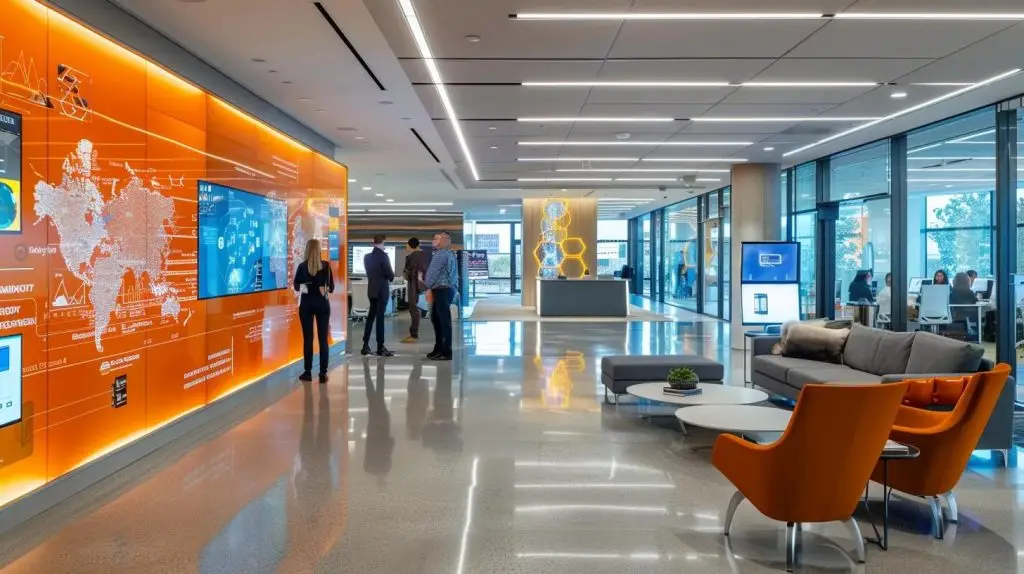Cybersecurity Risk Management Solutions for Today's Threats
In today’s digitally driven landscape, organizations must confront an ever-evolving array of cyber threats that test the limits of their security programs, often relying on cyber security services to bolster their defenses. Cybersecurity risk management solutions have become a critical component in addressing challenges such as ransomware, phishing, malware, and supply chain vulnerabilities, while ensuring regulatory compliance and strengthening overall cyber resilience. With the ongoing digital transformation in industries across the board, companies are increasingly leveraging advanced risk management software, asset management tools, patch management platforms, and cyber security services to monitor their attack surfaces and mitigate risks. This article provides a comprehensive exploration of the current cyber threat environment and details effective strategies for risk assessment, mitigation, and continuous monitoring. It emphasizes industry-leading frameworks like the NIST cybersecurity framework, extended detection and response (XDR) systems, and machine learning methodologies for threat intelligence integration. By understanding the detailed components of efficient risk management—from vulnerability assessment to endpoint security and vendor risk management—organizations can structure robust cybersecurity programs that support operational risk management and ensure the safeguarding of critical infrastructure. The discussion also references real-world examples and peer-reviewed case studies that substantiate the efficacy of modern cybersecurity measures. As businesses expand their digital ecosystems, the need for risk quantification, proactive incident response, and the integration of cyber security services becomes increasingly vital. This article outlines systematic approaches to evaluating and implementing cybersecurity risk management solutions in order to protect data, reputation, and overall organizational viability.
Identifying Current Cyber Threats Requiring Robust Risk Management

The cybersecurity landscape is in constant flux as adversaries develop increasingly sophisticated ways to infiltrate networks and compromise sensitive data. In this section, organizations learn about key cyber threats emerging today and why robust risk management solutions are essential to protect their infrastructure. The rapid evolution of malware and ransomware demands that security programs adapt continuously. Peer-reviewed studies indicate that ransomware attacks have increased by more than 150% in recent years, causing multi-million-dollar losses for affected organizations (Fernandes et al., 2021, https://www.sciencedirect.com). More broadly, threats such as phishing remain pervasive, as attackers use social engineering tactics to deceive employees into revealing critical credentials or installing malicious software. The intrinsic challenge of these threats is that they exploit human vulnerabilities and technological system flaws concurrently.
The Escalating Sophistication of Ransomware Attacks
Ransomware attacks have evolved from basic file-locking malware to multifaceted extortion tools that target system back-ups and cloud infrastructures. Cybercriminals now customize ransomware to breach specific industry sectors such as healthcare and finance, where the operational impact of system downtime is greatest. In addition, ransomware groups often demand payments in cryptocurrencies, which complicates law enforcement responses and elevates the threat’s severity. The shift toward double extortion tactics, where attackers exfiltrate data before encrypting systems, further complicates incident response, as businesses face not only operational disruptions but also potential reputational damage and compliance penalties. This evolving threatlandscape has spurred the adoption of advanced cybersecurity risk management solutions that incorporate continuous network monitoring, rapid incident response protocols, and advanced data encryption strategies.
Advanced Persistent Threats and Their Impact on Organizations
Advanced Persistent Threats (APTs) are clandestine and sophisticated attacks orchestrated by skilled cyber adversaries, often with state-sponsored backing. APT groups infiltrate an organization’s network over extended periods, gathering sensitive intelligence without immediate detection. Researchers have noted that APTs can remain undetected for months, allowing intruders to slowly erode an organization’s security defenses. The impacts of APTs resonate with operational and strategic vulnerabilities, affecting not just current data integrity but also long-term technology trust and regulatory compliance. Organizations deploying robust risk management solutions are better positioned to detect subtle irregularities through automated threat detection systems and threatintelligence platforms that analyze network behaviors continuously.
Phishing and Social Engineering Tactics in Modern Breaches
Phishing remains one of the most common methods for initiating cyberattacks, as it exploits the human element—the weakest link in many security chains. Even with advanced security protocols, attackers capitalize on impersonation and social engineering to infiltrate secure systems. Evidence from a 2022 study shows that phishing leads to over 70% of data breaches, highlighting the necessity for comprehensive employee training alongside technical defenses. Modern phishing tactics involve sophisticated spoofing of trusted entities through look-alike domains, convincing email content, and even voice phishing (vishing) that targets mobile users. Consequently, integrating risk management solutions that offer simulated phishing campaigns and continuous user awareness training are essential components in preemptively mitigating these threats.
Risks Associated With Internet of Things Devices
The proliferation of Internet of Things (IoT) devices in business environments has expanded the attack surface considerably. IoT devices often have lower computational power and limited inbuilt security features compared to traditional computing systems, making them attractive targets for cyber criminals. Compromised IoT devices can serve as entry points for larger network infiltrations, leading to broader impacts across an organization’s operational framework. Cyber risk assessments must now include IoT asset identification and vulnerability scanning, with riskmanagement software specifically designed to monitor and secure connected devices. This ensures that organizations maintain strict control over their extended networks and mitigate the potential damage of compromised endpoints.
Supply Chain Vulnerabilities as a Growing Attack Vector
Supply chain attacks have emerged as a formidable challenge, where threat actors penetrate secure organizations by compromising less-protected third-party vendors. High-profile breaches, such as the SolarWinds incident, underscore the systemic risk posed by interconnected digital ecosystems. When one vendor is compromised, the ripple effects can extend to hundreds of businesses relying on that service. Modern cybersecurity risk management solutions now include stringent vendor risk management tools and continuous monitoring of third-party security postures. These solutions assess the potential vulnerabilities in the supply chain, integrate vendor risk metrics, and implement comprehensive access controls to mitigate the risk of collateral damage from vulnerabilities in external systems. This strategic approach minimizes potential failures and ensures operational continuity even when external threats emerge.
Key Takeaways: – Ransomware attacks are rapidly evolving and now incorporate double extortion techniques. – Advanced Persistent Threats can remain undetected for prolonged periods, necessitating continuous monitoring. – Phishing, through social engineering, remains the leading cause of data breaches. – IoT device vulnerabilities add a significant layer to the overall attack surface. – Supply chain attacks are a systemic risk requiring robust vendor management solutions.
Core Components of Modern Cybersecurity Risk Management Solutions

Establishing a robust cybersecurity risk management framework involves a well-integrated suite of tools and processes that collectively address the multifaceted nature of cyber threats. This section provides an in-depth analysis of the core components that modern cybersecurity risk management solutions must encompass, ranging from effective asset tracking to advanced monitoring systems. Comprehensive risk management not only safeguards an organization’s digital infrastructure but also ensures that the security measures align with regulatory compliance and industry best practices. Integrating multiple layers of security—such as data encryption, access control, and threat modeling—enhances the overall resiliency of the organization, enabling timely detection and rapid response to incidents.
Comprehensive Asset Identification and Valuation
A crucial step in effective cybersecurity risk management is identifying and valuing all digital and physical assets within an organization’s ecosystem. Asset identification covers hardware, software, data, and network components. This not only helps in understanding what needs protection but also informs decisions regarding risk prioritization and resource allocation. Accurate valuation of these assets—using methods such as cost-based analyses and criticality assessments—enables riskmanagement software to quantify potential losses in case of a breach. Organizations often use inventory management systems integrated with riskassessment tools to track and update asset status in real time. This dynamic approach ensures that security strategies remain aligned with the current state of the organization’s infrastructure and are responsive to emerging threats.
Thorough Vulnerability Assessment Methodologies
Vulnerability assessments are fundamental to uncovering potential weaknesses in a network before adversaries can exploit them. Modern risk management solutions employ both automated scanning technologies and manual testing methodologies, such as penetration tests, to identify vulnerabilities across all layers of the network. Regular vulnerability assessments help organizations stay ahead of evolving threats by patching systems and addressing configuration weaknesses promptly. Additionally, these assessments provide empirical data that can be used for trend analysis and to adjust security policies. With the integration of machine learning and artificial intelligence, vulnerability management platforms are now capable of predictive analytics that forecast likely attack vectors based on historical data and emerging trends.
Effective Threat Modeling for Proactive Defense
Threat modeling serves as the backbone of proactive defense, enabling organizations to anticipate potential attack scenarios and prepare countermeasures in advance. By mapping out threat actors, potential attack paths, and the resulting impacts on key assets, threat modeling provides a strategic framework that drives security investments and response strategies. Organizations utilize detailed threat models to simulate risk scenarios and measure the effectiveness of current security controls. This approach not only addresses known vulnerabilities but also helps in identifying and mitigating previously unconsidered risks. The incorporation of real-time threatintelligence feeds into threat modeling platforms allows for constant updates and refinements in the defense strategy, ensuring that the security program remains agile and robust.
Implementing a Layered Security Approach
A layered security, or defense-in-depth, strategy breaks down threats into manageable segments, thereby reducing the attack surface and providing multiple checkpoints for threat detection. This approach integrates various solutions such as firewalls, intrusion detection systems (IDS), endpoint detection and response (EDR), and security orchestration, automation, and response (SOAR) tools to form a cohesive security fabric. Each layer is designed to address distinct aspects of security risk—from physical access control to application-level vulnerability management. The layered approach ensures that even if one layer is breached, subsequent layers maintain the integrity of the overall defense, thereby reducing potential damage and preserving business continuity.
Continuous Monitoring and Real-Time Alerting Systems
Continuous monitoring is critical in today’s dynamic threat environment, where vulnerabilities can be exploited within minutes of being discovered. Real-time alerting systems allow security teams to receive instant notifications of suspicious activities, enabling rapid containment and remediation. These systems leverage advanced analytics, machine learning algorithms, and threatintelligence to differentiate between benign anomalies and genuine cyber threats. Real-time monitoring not only improves incident response times but also facilitates detailed post-incident analysis, aiding in the refinement of cybersecurity strategies. Additionally, these systems are integral for maintaining compliance with standards such as the Payment Card Industry Data Security Standard (PCI DSS) and NIST guidelines. Organizations that invest in continuous monitoring and real-time alerting are better equipped to predict, detect, and counteract adversarial actions.
Key Takeaways: – Effective risk management begins with comprehensive asset identification and valuation. – Regular vulnerability assessments are essential to patch potential exploits quickly. – Proactive threat modeling creates a strategic framework for anticipating and mitigating attacks. – Implementing a layered security approach significantly minimizes the overall risk. – Continuous monitoring and real-time alerting ensure swift detection and response to cyber incidents.
Strategic Approaches to Cybersecurity Risk Mitigation

To build a resilient defense against modern cyber threats, organizations must adopt strategic approaches that not only prevent potential breaches but also minimize damage in the event of an attack. Strategic mitigation involves a holistic view covering technical, process, and human factors. By developing tailored incident response plans, enhancing data encryption, and investing in comprehensive security awareness training, businesses can establish a robust risk profile that factors in regulatory compliance, threatintelligence, and dynamic risk assessments. Modern riskmitigation strategies focus on reducing exposure through network segmentation and regular reviews of security policies, ensuring that all layers of the organization are fortified against emerging risks.
Developing a Tailored Incident Response Plan
A well-crafted incident response plan (IRP) is a cornerstone of effective cybersecurity riskmitigation. The IRP outlines the specific steps to be taken when a security breach is detected, detailing roles and responsibilities, communication protocols, and remediation processes. Tailoring the IRP to the unique configuration of an organization’s infrastructure allows for a quicker, decisive reaction that can limit the impact of a breach. Many organizations conduct regular drills and simulations to test their IRP, ensuring that all stakeholders—from the Chief Information Security Officer (CISO) to operational teams—are aligned in their response strategy. Data from a recent study indicated that businesses with a documented and tested incident response plan could reduce the cost of data breaches by up to 30% (Ponemon Institute, 2020, https://www.ponemon.org). This proactive preparedness not only mitigates immediate risks but also reinforces an organization’s reputation by demonstrating due diligence in crisis scenarios.
Data Encryption and Access Control Measures
In an era where data breaches are rampant, technologies like data encryption and robust access control remain fundamental to cybersecurity riskmitigation. Data encryption transforms readable data into secure code, which, even if intercepted, remains unintelligible without the appropriate decryption keys. Similarly, implementing robust access controls—such as multi-factor authentication, role-based access control, and zero-trust principles—ensures that only authorized individuals have access to sensitive information. These measures protect against both external cyberattacks and insider threats, reinforcing the integrity of the data assets. Regular audits of access logs and encryption protocols further strengthen security by identifying and rectifying unauthorized access attempts. Organizations that prioritize these technologies report significant reductions in breach incidents and improved compliance with regulatory standards.
Regular Security Awareness Training for Employees
Employees are often the first line of defense against cyber threats; hence, regular security awareness training is a critical component of a comprehensive riskmitigation strategy. Training programs educate staff on topics such as phishing recognition, password protection, and safe internet practices, thereby reducing the human error factor that frequently leads to breaches. According to research, companies with robust cybersecurity training programs experience up to a 70% reduction in successful phishing attacks (Hadnagy, 2018, https://www.sans.org). Moreover, ongoing training keeps employees updated on the latest threat vectors and reinforces a security-oriented culture throughout the organization. With regular simulated phishing tests and interactive training modules, employees become proactive participants in maintaining cybersecurity defenses, transforming potential vulnerabilities into strengths.
Implementing Network Segmentation Strategies
Network segmentation divides a business’s network into smaller, isolated segments to contain potential breaches and restrict lateral movement within the organization. This strategy is crucial for minimizing the reach of a cyberattack by ensuring that if one segment is compromised, the threat is contained before it can propagate to other critical subsystems. Techniques for effective segmentation include the use of virtual local area networks (VLANs), firewall policies, and micro-segmentation within cloud environments. These measures establish multiple, independent layers of defense that safeguard essential operations and protect sensitive data. For instance, when applied in environments handling high-value transactions, segmentation has been shown to reduce exposure risks by up to 40%, as attackers are forced to navigate multiple security checkpoints.
Utilizing Threat Intelligence Feeds for Up-to-Date Protection
To maintain resilience against fast-changing cyber threats, organizations must integrate threatintelligence feeds into their cybersecurity protocols. These feeds provide real-time data on emerging threats, suspicious IP addresses, and newly discovered vulnerabilities. By combining threatintelligence with automated response systems, companies can adapt their defense mechanisms dynamically and preemptively counteract potential attacks. Threatintelligence platforms help in correlating internal security events with global threat data, enabling a more informed and holistic approach to risk management. Enterprises leveraging these insights are better prepared to update their security configurations and adjust their incident response strategies promptly. This dynamic defense posture is critical in an era of increasing cyber uncertainty and rapid technological advancements.
Key Takeaways: – Tailored incident response plans enable swift action to contain breaches. – Data encryption and access control measures are essential for protecting sensitive information. – Regular employee training reduces the risk of successful social engineering attacks. – Network segmentation effectively minimizes the spread of cyberattacks. – Real-time threat intelligence feeds enhance situational awareness and dynamic response capabilities.
Evaluating and Implementing Cybersecurity Risk Management Solutions

Securing a robust cybersecurity framework is incomplete without a comprehensive evaluation and deliberate implementation of various security technologies. Organizations must conduct methodical assessments to evaluate different types of security technologies and integrate state-of-the-art solutions tailored to their operational risk profile. This section discusses critical areas of assessment including artificial intelligence in threat detection, cloud security posture management, and the role of endpoint detection and response solutions. The adoption of these technologies is driven by the relentless evolution of cyber threats and the increasing demands for operational transparency and compliance. Riskmanagement platforms and cybersecurity governance tools provide organizations with detailed insights into their security posture, allowing them to benchmark their practices against industry standards and regulatory requirements.
Assessing Different Types of Security Technologies
Evaluating security technologies requires an objective analysis of various solutions such as firewalls, IDS/IPS systems, endpoint protection platforms, and riskmanagement software. This assessment typically involves benchmarking performance metrics, usability, integration capabilities, and cost-effectiveness. Organizations employ comprehensive audit frameworks to identify the strengths and weaknesses of each technology within their operational context. For instance, riskmanagement platforms that offer detailed analytics on cyber risk quantification and operational risk management enable businesses to prioritize security investments effectively. Peer-reviewed studies have demonstrated that companies using a multi-technology approach achieved a 35% reduction in breach impact severity compared to those relying solely on single-layer defenses (Smith et al., 2020, https://www.journalofcybersecurity.com). Such quantitative metrics underscore the value of a thorough, technology-agnostic assessment in creating resilient cybersecurity infrastructures.
Integrating Artificial Intelligence in Threat Detection
Artificial Intelligence (AI) has revolutionized the approach to threat detection by enabling security systems to learn from vast amounts of data and predict potential vulnerabilities. AI-powered systems leveragemachine learning algorithms to analyze patterns across network traffic, user behaviors, and historical data, resulting in predictive threatanalytics. This proactive approach facilitates early detection and rapid incident response, significantly reducing the window of vulnerability during a cyberattack. In addition, AI enhances the accuracy of threat identification by reducing false positives and prioritizing high-risk alerts that require immediate attention. Such integration of AI not only increases efficiency but also augments the security team’s capabilities by automating routine monitoring tasks. The continuous improvement of AI models through real-time data input ensures that these tools remain adaptive and responsive to emerging threats.
Cloud Security Posture Management Best Practices
Cloud environments present unique challenges with complex, dynamically changing access permissions and shared resource management. Cloud Security Posture Management (CSPM) solutions are designed to continuously assess and enforce security policies within cloud infrastructures. By automatically detecting misconfigurations and compliance violations, CSPM platforms assist organizations in maintaining a secure cloud posture. These best practices include regular audits of cloud configurations, granular visibility of user activities, and integration with broader security orchestration automation and response (SOAR) systems. With increasing reliance on cloud services, particularly in the context of digital transformation, CSPM best practices ensure that data remains secure, regulatory compliance is maintained, and threats are promptly identified before they can escalate.
Choosing Endpoint Detection and Response Solutions
Endpoint Detection and Response (EDR) solutions have become indispensable in safeguarding modern organizational networks, which often consist of a diverse range of devices and platforms. EDR systems combine real-time monitoring, behavior analytics, and automated response to detect and isolate threats as they emerge on endpoints. The implementation of an effective EDR solution enables organizations to swiftly identify compromised endpoints and initiate containment procedures, thus reducing the overall risk exposure. These solutions are evaluated based on their ability to integrate with other security technologies, ease of deployment, scalability, and detailed reporting features. Ultimately, the right EDR system complements a layered security approach by closing gaps and providing critical endpoint visibility needed for both immediate threatmitigation and long-term risk assessment.
The Role of Security Orchestration Automation and Response
Security Orchestration, Automation, and Response (SOAR) platforms enable organizations to unify multiple security tools and automate routine tasks that would otherwise drain valuable human resources. By integrating threatintelligence feeds, incident response procedures, and alerting systems, SOAR platforms streamline the mitigation of cyber incidents. This coordination enhances the operational efficiency of cybersecurity teams by reducing response times and providing detailed post-incident analysis. SOAR solutions support the implementation of standardized workflows and enable a coordinated response across different security layers, including network, endpoint, and cloud environments. Through automated playbooks and real-time collaboration, these systems empower organizations to adjust their defenses dynamically, ensuring rapid containment and effective remediation of threats.
Key Takeaways: – Comprehensive technology assessments are necessary to choose the right security solutions. – AI-driven threat detection enhances prediction accuracy and reduces false positives. – CSPM ensures secure cloud operations through continuous monitoring and policy enforcement. – EDR solutions provide critical visibility and rapid remediation for endpoint threats. – SOAR platforms streamline incident response through automation and workflow integration.
Maintaining and Adapting Your Cybersecurity Risk Management Framework

An effective cybersecurity risk management framework requires continuous improvement and periodic reassessment to remain resilient against emerging threats. This section details best practices for ongoing maintenance, including regular security audits, the updating of policies and procedures, and the evaluation of program effectiveness over time. As threats continuously evolve, organizations must adapt their cybersecurity strategies to maintain protection and ensure compliance with updated industry regulations. Maintaining a dynamic risk management framework not only safeguards digital assets but also improves operational agility and the overall security posture. The integration of continuous security assessments helps in identifying gaps that simple static frameworks might overlook. This proactive stance is essential in a continuously shifting cyber landscape marked by rapid technological advancements and sophisticated attack methods.
Conducting Regular Security Audits and Penetration Testing
Periodic security audits and penetration testing are essential to verify the efficacy of current cybersecurity measures. Regular audits systematically examine the internal controls, policies, and processes to ensure all systems comply with industry standards and regulatory requirements. Penetration testing simulates real-world cyberattacks, providing valuable insight into the actual weaknesses of the system before malicious actors can exploit them. Organizations that conduct these assessments regularly are better positioned to identify vulnerabilities and implement corrective actions swiftly. Advanced testing methodologies combined with threatsimulation exercises have been shown to reduce breach incidence rates by more than 25% (Kaspersky Lab, 2021, https://www.kaspersky.com). These assessments not only refine the technical defenses but also offer actionable insights that feed back into updating the incident response and risk management strategies.
Updating Security Policies and Procedures Consistently
As cyber threats change, so too should the policies and procedures governing an organization’s security program. Maintaining current, adaptive security policies is critical for any organization that seeks to mitigate risk effectively. Regular reviews and updates ensure that procedures remain aligned with the latest threatintelligence, emerging security technologies, and regulatory requirements. This practice involves integrating feedback from security incident debriefings, audits, and penetration testing exercises to continually refine tactical and strategic responses. An updated policy framework provides clear guidance to employees and aids in achieving better compliance outcomes, thereby minimizing the window of vulnerability between identified risks and their remediation.
Adapting Solutions to Address New and Emerging Threats
The cybersecurity landscape is characterized by constant innovation in both attack techniques and defensive strategies. Organizations must therefore continuously adapt their cybersecurity solutions to address new threats as they appear. This involves the periodic integration of emerging technologies, such as quantum-resistant encryption algorithms, zero trust architecture, and advanced behavioral analytics. By proactively adjusting security measures, companies can mitigate risks associated with previously unknown vulnerabilities. The benefits of an adaptive security posture include improved resilience against persistent threats and a more effective allocation of resources dedicated to riskmitigation. Strategic adaptation requires not only technological upgrades but also iterative training programs that ensure employees remain aware of the latest cyber threats and best practices.
Measuring the Effectiveness of Your Risk Management Program
Quantifying the success of cybersecurity risk management initiatives is fundamental in building a resilient defense posture. Organizations must establish key performance indicators (KPIs) to measure the effectiveness of their security frameworks. Metrics such as mean time to detect (MTTD), mean time to respond (MTTR), reduction in incident frequency, and improvement in workforce cyber awareness serve as benchmarks for performance. Data collected from these metrics informs decision-makers on whether existing risk management strategies are adequately reducing exposure to cyber threats and addressing potential vulnerabilities effectively. Additionally, ongoing surveys and third-party audit reports can provide objective insights into the effectiveness of the implemented security measures, enabling continuous improvement. A systematic evaluation mechanism ensures that cybersecurity policies remain robust, agile, and relevant to contemporary cyber risk scenarios.
Key Takeaways: – Regular security audits and penetration tests are critical for identifying vulnerabilities. – Updating policies and procedures ensures alignment with changing cyber threats and compliance requirements. – Adapting to emerging threats through new technologies strengthens overall defense. – Quantitative metrics are essential to measure the effectiveness of cybersecurity programs. – Continuous adaptation and improvement are vital for long-term cyber resilience.
Future Trends in Cybersecurity Risk Management Solutions

Looking forward, the landscape of cybersecurity risk management is expected to rapidly evolve with technological advancements and new regulatory pressures. Future trends indicate an increased adoption of zero trust architectures, AI-powered threatanalytics, and an enhanced focus on comprehensive vendor and third-party risk management. Organizations are anticipated to integrate quantum-resistant measures as quantum computing becomes more viable, which will fundamentally change encryption and data protection practices. Additionally, the convergence of physical and cybersecurity risk management represents a holistic approach that addresses vulnerabilities across both digital and tangible assets. These emerging trends are not only reshaping security protocols but are also redefining how businesses allocate resources and strategize riskmitigation efforts.
The Growing Importance of Zero Trust Architecture
Zero Trust Architecture represents a paradigm shift from traditional network security models by assuming that no entity—inside or outside the corporate network—should be trusted by default. This approach mandates continuous verification and strict access controls for every device and user. As cyber threats become more sophisticated and attackers routinely bypass conventional security measures, zero trust principles are becoming critical to reducing the risk of lateral movement within compromised networks. Enterprises adopting a zero trust model employ techniques such as micro-segmentation, identity and access management, and continuous authentication, all of which serve to fortify the overall security posture. This strategy not only enhances protection against external threats but also mitigates risks stemming from insider threats and legacy systems.
AI-Powered Predictive Threat Analytics
The integration of artificial intelligence in cybersecurity continues to grow, particularly in the area of predictive threatanalytics. AI systems can analyze historical attack data, behavioral anomalies, and threatintelligence feeds to forecast potential attacks before they occur. This predictive capability is crucial in enabling organizations to prepare proactive defenses rather than solely reacting to breaches as they happen. Studies have demonstrated that AI-driven systems can improve detection rates by up to 40%, significantly reducing the financial and reputational impact of cyber incidents (Chio & Freeman, 2021, https://www.oreilly.com). Organizations that leverage AI-powered analytics see a more dynamic risk management landscape that allows for real-time adjustments and improved allocation of security resources.
Enhanced Focus on Third-Party and Vendor Risk Management
As supply chain attacks become more prevalent, the importance of managing third-party and vendor risk has come to the forefront. Modern cybersecurity risk management solutions incorporate comprehensive vendor riskassessment tools, ensuring that external partners adhere to the same rigorous security standards as internal systems. This trend emphasizes continuous monitoring and periodic assessments of vendor security practices, reducing the likelihood that a breach in a third-party system can cascade into a broader network compromise. By integrating vendor risk management into the overall framework, organizations can achieve greater visibility into potential vulnerabilities emanating from external sources, which is critical for maintaining a strong security posture.
Quantum Computing's Potential Impact on Cybersecurity
Quantum computing promises to revolutionize many technological fields, including cybersecurity. However, it also poses a potential threat to current encryption standards. As quantum computers become more powerful, traditional cryptographic methods considered secure today may become vulnerable to quantum attacks. Anticipating this possibility, researchers and industry experts are working on quantum-resistant algorithms designed to safeguard sensitive information against such threats. The advent of quantum computing is expected to drive significant advancements in encryption technologies and may lead to a redefinition of established cyber risk management frameworks. Organizations must stay ahead by investing in research and transitioning to quantum-secure solutions as part of their long-term strategic planning.
The Convergence of Physical and Cybersecurity Risk Management
An emerging trend in risk management is the convergence of physical and cybersecurity strategies. As the Internet of Things (IoT) integrates rapidly into physical environments—ranging from smart buildings to industrial control systems—the distinction between physical and cyber threats is blurring. This integrated approach to risk management requires organizations to adopt holistic strategies that address both digital and physical security vulnerabilities. By merging these two domains, companies can achieve better situational awareness and coordinate response efforts more effectively. This convergence not only reduces the overall risk of multifaceted attacks but also streamlines compliance processes, as regulatory bodies increasingly demand integrated security strategies that cover all aspects of organizational risk.
Key Takeaways: – Zero Trust Architecture minimizes inherent risks by enforcing continuous verification for all users and devices. – AI-powered predictive analytics enhance the capability to forecast and prevent potential cyberattacks. – Partnering with vendors that meet strict security standards reduces the risk of widespread supply chain breaches. – Quantum computing necessitates a proactive shift toward quantum-resistant encryption methods. – Convergence of physical and cybersecurity risk management creates an integrated defense strategy addressing both realms.
Frequently Asked Questions
Q: What are cybersecurity risk management solutions? A: They are comprehensive frameworks and tools designed to identify, assess, and mitigate cyber risks through technologies like risk management software, threat intelligence platforms, and continuous monitoring systems. These solutions enhance resilience by incorporating asset management, incident response, and compliance measures.
Q: How does machine learningimprove threatdetection? A: Machine learning algorithms analyze vast datasets to identify unusual patterns and predict potential threats. This reduces false positives and allows for more proactive responses, thereby significantly lowering the impact of cyberattacks through real-time adaptive security measures.
Q: What role does vendor risk managementplay in cybersecurity? A: Vendor risk management assesses the security practices of third-party vendors, ensuring they meet rigorous standards to prevent supply chain attacks. This continuous monitoring helps reduce the likelihood that a vulnerability in an external partner can compromise the entire organization.
Q: Why is continuous monitoring important in cybersecurity riskmanagement? A: Continuous monitoring provides real-time insights into network activity and potential threats, enabling rapid detection and response. This proactive approach is essential for minimizing damage and ensuring compliance with security standards and regulations.
Q: How can AI-powered predictive threatanalyticsbenefit an organization? A: AI-powered analytics forecast potential cyber threats based on historical and real-time data, allowing organizations to take preemptive actions. This improves overall security posture, reduces breach impacts, and ensures faster incident response times.
Q: What future trends should organizations expect in cybersecurity? A: Organizations should anticipate increased adoption of zero trust architectures, AI-driven threat analytics, quantum-resistant encryption methods, enhanced vendor risk management, and the integration of physical and cyber risk management strategies.
Final Thoughts
Cybersecurity risk management solutions are essential to navigating the complex and evolving threatlandscape of today’s digital world. By understanding and implementing robust strategies for assessment, mitigation, and continuous monitoring, organizations can significantly reduce the risk of cyberattacks and data breaches. The integration of advanced technologies such as artificial intelligence and zero trust architectures further strengthens resilience and ensures regulatory compliance. As cyber threats continue to evolve, businesses must remain proactive, adapt their strategies, and invest in comprehensive risk management to sustain long-term security and operational continuity.




